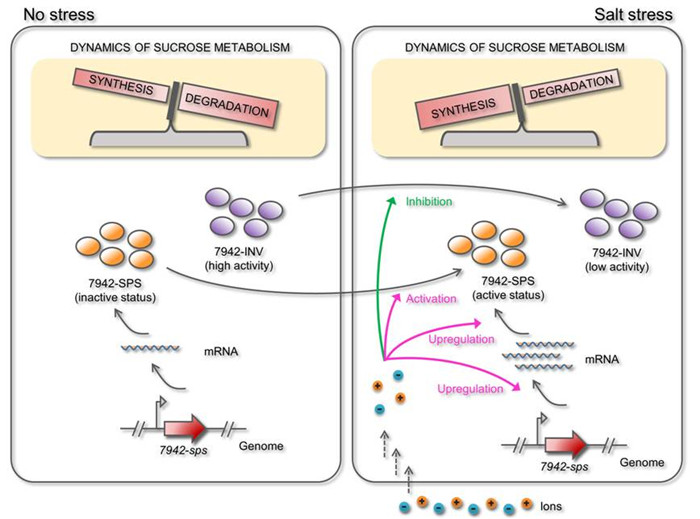How Do Cyanobacteria Adapt to an Environment with High Salt Concentration?
Cyanobacteria are a class of the oldest microorganisms on our planet. They are able to perform plant-type oxygenic photosynthesis, converting atmosphere CO2 and light energy to a variety of carbohydrates. Scientists have discovered that many cyanobacteria synthesize and accumulate small water-soluble molecules (compatible solutes, e.g. sucrose) under salt (e.g. NaCl) stress conditions for environmental adaption, however, the basic mechanisms of these processes still remain not well understood.
By systematically analyzing the genetic and biochemical changes of sucrose synthesis in the freshwater cyanobacterium Synechococcus elongatus, an “ion-mediated enzymatic regulation” mechanism for the salt-induced accumulation of compatible solutes was recently revealed by the metabolic engineering group of Qingdao Institute of Bioenergy and Bioprocess Technology (QIBEBT), Chinese Academy of Sciences (CAS).
Upon salt stress, the pre-existing sucrose synthesizing enzyme SPS is immediately activated by the elevated intracellular ion concentrations, which in turn initiates the fast accumulation of sucrose in the cell for osmotic balance. When the environmental salinity decreases, the intracellular ion concentration is also lowered. This reduces SPS activity and weakens sucrose synthesis in the cell.
More interestingly, the activity of the sucrose degrading enzyme INV is regulated in a contrary manner, i.e. inhibited by elevated ion concentrations and activated by decreased ion concentrations. Thus the ion-mediated enzymatic modulation of sucrose synthesizing/degrading activities synergistically regulates the sucrose content in the cell (Figure 1). This mechanism allows a fast response of cyanobacterial cells to the change of environmental salinity. It may be the predominant manner to regulate intracellular compatible solutes by cyanobacteria and possibly other microbes.
The above findings were recently published in the journal of Applied and Environmental Microbiology. This study was funded by the National Science Fund for Distinguished Young Scholars of China, the National Science Foundation of China Project, the Shandong Key Basic Research Project, and the Shandong Taishan Scholarship.

Figure1: Schematic illustration of the proposed regulatory mechanism of salt-induced sucrose accumulation in Synechococcus elongatus in response to salt stress. (Image by LUO Quan)
(Text by LUO Quan)
Contact:
CHENG Jing
Qingdao Institute of Bioenergy and Bioprocess Technology, Chinese Academy of Sciences
Tel: 86-532-80662647/80662622
E-mail: chengjing@qibebt.ac.cn